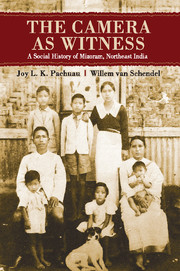Book contents
- Frontmatter
- Contents
- List of Figures
- List of Maps
- Acknowledgements
- I Becoming Mizo
- 1 Introduction
- 2 Coming into View: The First Portraits
- 3 Adjusting Mizo Culture
- 4 Domesticating a New Religion
- 5 Getting Educated
- 6 Controlling the Hills
- 7 The Trouble of Travel
- 8 First Stirrings of the Market Economy
- 9 Mizos in the World Wars
- 10 Mizo Visual Sensibilities
- II Mizoram in the New India
- III Visions of Independence
- IV Mizo Modernities
- Copyrights and Sources
- Glossary
- Bibliography
- Index
1 - Introduction
from I - Becoming Mizo
Published online by Cambridge University Press: 05 May 2015
- Frontmatter
- Contents
- List of Figures
- List of Maps
- Acknowledgements
- I Becoming Mizo
- 1 Introduction
- 2 Coming into View: The First Portraits
- 3 Adjusting Mizo Culture
- 4 Domesticating a New Religion
- 5 Getting Educated
- 6 Controlling the Hills
- 7 The Trouble of Travel
- 8 First Stirrings of the Market Economy
- 9 Mizos in the World Wars
- 10 Mizo Visual Sensibilities
- II Mizoram in the New India
- III Visions of Independence
- IV Mizo Modernities
- Copyrights and Sources
- Glossary
- Bibliography
- Index
Summary
Tectonic plates move across the surface of the earth. One of these is the India plate. Slowly but relentlessly it pushes its way underneath the Eurasian plate to the north. This produces wrinkles on the earth's surface. The best known of these is the long ridge of the Himalayas that separates South Asia from Tibet. This book focuses on a related wrinkle. At their eastern end, the Himalayas are linked to a range of mountains that run south from Tibet (China) to Arakan in western Burma. Crescent-shaped, these steep mountains are often seen as the boundary separating South Asia from Southeast Asia. They do not have a single name, and despite their height (the highest peaks reach over 3000 m), they are often referred to as hills. Thus, they are known as the Naga Hills in the north, the Mizo, Chin and Chittagong hills in the centre and the Arakan hills in the south (see Map 1.1).
Why this book?
For many years, social scientists and historians have overlooked the societies of these hills. This is partly because state-imposed barriers severely hampered access. The lack of new research has resulted in the survival of problematic colonial-era images – mainly regarding primitivism, exoticism and stagnation – which have long been challenged elsewhere. The historian's task has been described as that of a hunter of myths, or an eradicator of false conceptions; that task is an urgent one for this large region covering parts of India, Burma (Myanmar) and Bangladesh. Many myths and misunderstandings about these societies continue to swirl around public discourses and policymaking at national and international levels, whilst local voices are largely unheard, if not actively silenced. The consequences have been tragic. As the national armed forces of India, Burma and Bangladesh waged war on local populations, and inhabitants confronted each other violently, outdated ideas of ‘tribal’ backwardness merged with security thinking to create an atmosphere of despair, repression and recrimination.
- Type
- Chapter
- Information
- The Camera as WitnessA Social History of Mizoram, Northeast India, pp. 3 - 23Publisher: Cambridge University PressPrint publication year: 2015

